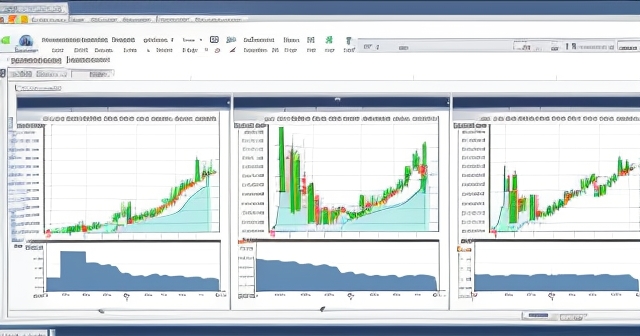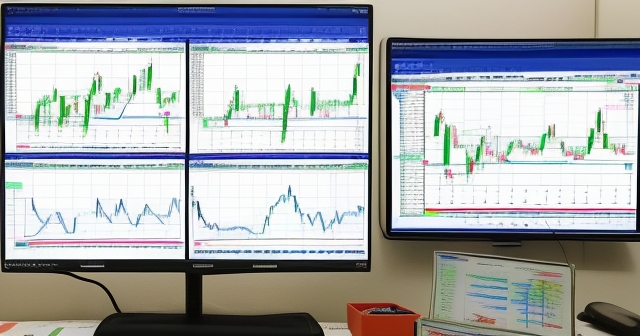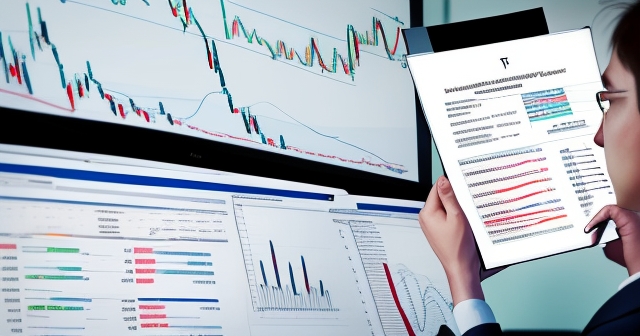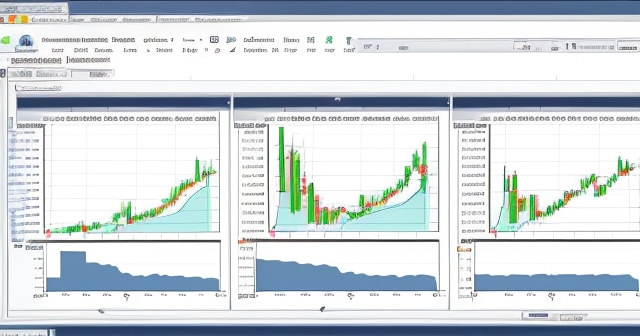Unpacking the NAAIM Exposure Index: A Deep Dive for the Astute Investor
Welcome, aspiring and experienced traders. Today, we embark on a journey to understand a fascinating data point in the complex world of financial markets: the NAAIM Exposure Index. If you’re navigating the vast landscape of technical analysis and market sentiment indicators, this index offers a unique perspective, not as a crystal ball predicting the future, but as a valuable snapshot of how a specific group of professional money managers is actually positioned in US equity markets.
In finance, having diverse tools in your analytical toolkit is key. While price charts, moving averages, and oscillators tell us about market action itself, indicators like the NAAIM Exposure Index provide insight into the collective behavior and risk appetite of active participants. Think of it less like reading the weather forecast and more like understanding whether experienced sailors are currently setting a lot of sail or dropping anchor. This distinction is crucial, and we’ll explore why throughout our discussion.
We aim to demystify this index, helping you understand what it measures, where the data comes from, and most importantly, how to interpret it responsibly as part of your broader market analysis. Our goal, aligned with our brand’s mission, is to empower you with knowledge, making complex financial concepts more accessible and actionable.

Understanding the NAAIM Exposure Index requires an overview of its significance, including the dynamics of active versus passive investing. Here are three key points:
- The unique role of active managers in navigating market volatility.
- An index reflecting their collective risk appetite, contrasting passive investment strategies.
- The importance of data interpretation for better investment decisions.
Why Focus on Active Investment Managers? Understanding the Landscape
You might be wondering, why specifically track the exposure of active investment managers? The financial world is broadly divided between passive investing (like buying index funds and holding them long-term) and active investing (where managers actively buy, sell, and adjust portfolio allocations to try and outperform a benchmark). NAAIM members represent a significant segment of the latter – professional fiduciaries who are actively managing client capital with the goal of generating favorable risk-adjusted returns.
Unlike passive investors who largely remain fully invested regardless of market conditions, active managers frequently adjust their exposure levels. They might increase cash holdings, reduce equity positions, employ hedging strategies, or even take leveraged short positions based on their market outlook and risk assessments. The NAAIM Exposure Index captures the aggregate result of these dynamic adjustments by a specific group of these professionals.
Observing the collective positioning of active managers provides a window into their current conviction levels regarding the market’s direction and perceived risk. Are they aggressively buying dips? Are they defensively raising cash? Are they employing hedges? The index, while simplified, attempts to answer these questions on an aggregate level for its survey participants. Understanding their posture can offer a layer of context to your own analysis, especially if you’re interested in understanding the flow of professional capital and how it might differ from passive flows.

The Engine Room: How the NAA NAAIM Exposure Index is Calculated
At its core, the NAAIM Exposure Index is derived from a simple yet insightful weekly survey. Every week, NAAIM member firms are asked to report their overall equity exposure at the close of trading on a specific day (usually Wednesday). This isn’t about reporting performance or specific holdings; it’s about stating the *net* exposure level their actively managed accounts have to US equity markets.
The firms provide a single composite number representing this exposure. This number takes into account long positions, short positions, leveraged positions, and cash. For example, a firm that is 100% invested in US stocks with no short positions would report 100%. A firm with 50% in stocks and 50% cash would report 50%. A firm with 120% exposure through leverage and 20% in cash would report 120%. A firm that is net short might report a negative number.
Once the responses are collected from the participating firms (referred to as the “NAAIM Trend Setters”), NAAIM calculates a weighted average of these responses. This average represents the overall NAAIM Exposure Index for that week. The methodology aims to provide a single, digestible figure that summarizes the collective stance of this group of active managers towards US equities. This weekly cadence allows for tracking changes in sentiment and positioning over relatively short periods, providing a dynamic view rather than a static one.

Decoding the Numbers: The Range of Possible Responses (-200% to +200%)
The range of possible responses in the NAAIM survey is quite broad, spanning from -200% to +200%. Understanding what these percentages signify is critical to interpreting the index’s weekly value. Let’s break down the key points along this spectrum:
- +200%: Leveraged Long. A response of +200% indicates that a manager is not only fully invested (100%) but has also utilized leverage to effectively double their exposure to US equities. This represents a very aggressive, bullish stance, suggesting strong conviction in rising prices.
- +100%: Fully Invested. A response of +100% means the manager’s entire investable capital is allocated to US equities, with no cash or short positions impacting the net exposure. This is a standard bullish position, but without the added risk of leverage.
- 0%: 100% Cash or Market Neutral. A response of 0% implies the manager has no net exposure to the direction of the US equity market. This could be achieved by holding 100% of assets in cash, or by employing a market-neutral strategy where long and short positions are balanced to cancel out directional risk. This is a highly defensive or non-directional stance.
- -100%: 100% Short. A response of -100% means the manager has short positions equivalent to the value of their capital, with no long positions offsetting this. This is a very aggressive, bearish stance, betting heavily on falling prices.
- -200%: Leveraged Short. A response of -200% indicates the manager is not only 100% short but has also used leverage to double this short exposure. This is an extremely bearish and high-risk position, typically seen only when managers have very high conviction that the market is about to experience a significant decline.
The NAAIM Exposure Index, being an *average* of these responses, will fall somewhere within this wide range. A reading of, say, 75% means the average active manager surveyed is 75% net long US equities. A reading of 10% would indicate a much more cautious, mostly cash or market-neutral stance on average. Extremes in the average can signal strong collective conviction in one direction or another, but it’s always the *average* of diverse individual strategies.

The Latest Reading: A Notable Weekly Shift (June 12, 2024 Data)
Now, let’s anchor our understanding with the most recent data point provided. For the week ending June 12, 2024, the NAAIM Exposure Index registered a value of 86.30. What does this number tell us at first glance? It indicates that, on average, the surveyed active investment managers were 86.30% net long US equities at the close of that week.
But the real story often lies in the *change* from the previous period. The index value for the week ending June 05, 2024, was 68.65. Comparing these two figures, we see a significant increase: the index jumped by 17.65 points (86.30 – 68.65). This represents a percentage change of approximately +25.71% week-over-week ((86.30 – 68.65) / 68.65 * 100%).
This substantial weekly rise suggests a notable shift in positioning among the surveyed active managers. Collectively, they moved from a moderately bullish stance (68.65% net long) to a more strongly bullish stance (86.30% net long) in the span of just one week. Such a rapid increase could indicate growing confidence, a reaction to recent market movements, or perhaps a deployment of cash that had been sitting on the sidelines. Observing these shifts is where the index derives much of its value, as it shows *action* taken by professionals.
Putting it in Perspective: Historical Context and Other Data Points
While the weekly change is interesting, understanding the current reading of 86.30 requires historical context. Is 86.30 a high number? A low number? How does it compare to past periods?
Looking back exactly one year, to the week ending June 12, 2023, the NAAIM Exposure Index stood at 90.07. Comparing the current 86.30 to this figure reveals that the average exposure is actually slightly lower than it was at the same time last year, specifically by 3.77 points, or approximately -4.19% year-over-year. This tells us that despite the recent bullish surge in positioning during the first week of June 2024, active managers on average haven’t quite reached the same level of equity exposure they maintained in mid-June of the previous year.
Let’s also consider other provided data points to broaden our perspective:
- On March 19, 2025 (a future date provided in the source data, perhaps a typo for 2024 or a hypothetical future scenario, but we will use the provided number), the index was 64.64. If this data point were from March 2024, it would indicate that the current exposure of 86.30 is significantly higher than it was just a few months prior. This would further emphasize the increase in bullishness observed since early spring.
- The average index value for Quarter 4 of 2024 was 85.81. Comparing the current 86.30 to this quarterly average, we see that the current positioning is very close to the average level maintained by active managers during the final quarter of the previous year. This suggests that while there was a recent surge, the overall level of exposure has returned to a range that was common in late 2024.
By considering these comparisons – weekly, yearly, and against other periods – we gain a richer understanding of the 86.30 figure. It shows strong recent conviction relative to the immediate past week, but a slightly lower conviction relative to the same time last year, and a positioning level roughly in line with the average from Q4 2024. This historical perspective is vital for moving beyond just the number itself and seeing the trend in active manager positioning.
Crucial Interpretation: Actual Positioning, Not Predictive Signals
Perhaps the most critical point to grasp about the NAAIM Exposure Index is its nature: it is explicitly stated as not predictive. This is not an indicator designed to forecast where the market *will* go. Instead, its value lies in showing you where active managers *were* positioned at a specific point in time, and more importantly, how their collective positioning has *changed* over the past week or two.
Think of it this way: When the weekly survey results are published, the decisions that led to those exposure levels have already been made and executed. The index shows the aftermath of their analysis, risk assessments, and trading decisions. It’s like looking at a thermometer to see the current temperature, not a weather model predicting next week’s temperature. The temperature is a fact about the present (or very recent past), not a forecast of the future.
So, when you see a significant jump in the index, like the recent move from 68.65 to 86.30, it doesn’t mean the market is guaranteed to go up next week. What it *does* mean is that, collectively, the active managers surveyed felt confident enough (or compelled enough by their strategies) to increase their net long exposure to US equities during the week leading up to June 12th. This tells you about their *actual behavior* and *current level of risk-taking* at that moment.
Why is this valuable? It provides a data-driven look at the sentiment and positioning of a group of sophisticated market participants. If the index is consistently high, it suggests these managers are generally bullish and heavily invested. If it drops significantly, it suggests they are collectively reducing risk or turning more cautious/bearish. Observing these shifts can provide context about which market moves are being accompanied by increased or decreased professional conviction, as expressed through their capital allocation.

Acknowledging the Edges: Limitations and Nuances of the Data
Like any financial indicator or dataset, the NAAIM Exposure Index comes with its own set of limitations and nuances that you must consider when incorporating it into your analysis. Understanding these helps you use the data more effectively and avoid misinterpretations.
NAAIM itself highlights several data collection challenges:
- Single Composite Number: Each advisor provides just one number representing their overall exposure. This is a simplification. Complex strategies involving options, futures, pairs trading, or specific sector hedges might not be fully captured by this single figure. A firm might have significant gross long and short positions that net out to a low exposure number, but their underlying strategy is far from “market neutral” in practice.
- Wide Variety in Manager Investment Styles: The NAAIM Trend Setters group includes managers with diverse strategies, time horizons, and asset allocation focuses. Some might trade frequently, others infrequently. Some might focus on large caps, others on small caps. Averaging their exposure levels provides a broad picture, but it smooths over the potentially very different actions being taken at the individual firm level. The index is an average, not a representation of any single manager’s book.
- Sample Size: The NAAIM Trend Setters is a specific group of member firms, but it is not a representation of *all* active money managers globally or even just within the US. The sample size, while consistent, might not perfectly reflect the positioning of the entire universe of active managers. Therefore, the index provides insight into the positioning of *this specific surveyed group*, not necessarily the market as a whole.
Furthermore, remember that active managers, despite their professionalism, are not infallible. Their collective positioning, as reflected in the index, can be right or wrong regarding future market movements. A high exposure reading doesn’t guarantee a bull market continuation, just as a low reading doesn’t guarantee a crash. Their positioning reflects their past decisions based on their information and models at that time.
Using the index requires acknowledging these edges. It’s one data point from one specific group, subject to aggregation effects and sample limitations. It’s best viewed as a piece of the puzzle, not the entire picture.
NAAIM Index and Market Action: Observing Historical Relationships (S&P 500 Context)
While the NAAIM Exposure Index isn’t predictive, charts often display it alongside a market benchmark like the S&P 500 Total Return Index. Observing these charts allows you to see how the collective positioning of active managers has historically corresponded with market movements.
Often, you might see periods where a rising S&P 500 is accompanied by increasing NAAIM exposure, suggesting managers were adding to positions as the market climbed. Conversely, market declines might coincide with falling exposure, indicating risk reduction. However, these correlations are not always perfect or consistent.
Sometimes, you might observe divergences. For instance, the market might continue to rise while the NAAIM index starts to flatten or decline, suggesting active managers are not participating as enthusiastically in the rally. Or, the market might dip, but the index stays relatively high, indicating managers are holding their ground or seeing dips as buying opportunities.
Analyzing these historical relationships can offer interesting insights into the psychology and strategy of this cohort of managers. It can help you understand if the current market move is being “followed” by active professional capital allocation or if there’s a divergence in conviction levels. However, it’s crucial to reiterate that past correlation does not imply future causation or predictive power. You are observing historical data points side-by-side.

Integrating the NAAIM Index into Your Analysis: A Piece of the Puzzle
So, how can you, as an investor or trader, effectively use the NAAIM Exposure Index? Since it’s not a predictive signal, you won’t use it to generate direct buy or sell orders in isolation. Its value lies in providing context and a different perspective alongside the other tools in your technical and fundamental analysis toolkit.
Here are a few ways you might consider integrating the NAAIM Index into your process:
- Gauging Professional Sentiment (of this specific group): A high and rising index suggests bullish conviction and increased risk-taking among surveyed active managers. A low and falling index suggests caution, risk reduction, or bearish sentiment. This offers insight into the prevailing mood among this professional cohort.
- Identifying Extremes: Very high or very low readings might indicate widely held consensus among this group. While extremes don’t necessarily mean the market will reverse (remember, not predictive!), they can sometimes precede shifts in market dynamics or simply highlight periods of intense professional conviction.
- Contextualizing Market Moves: If the market is rallying sharply, is the NAAIM index confirming this by rising (managers participating)? Or is it flatlining or falling (managers cautious despite the rally)? This comparison can add nuance to your interpretation of price action.
- Complementing Other Indicators: Use the index alongside sentiment surveys, put/call ratios, market breadth indicators, and traditional technical analysis tools. Does the NAAIM index align with other measures of sentiment and positioning, or does it diverge? Divergences can sometimes be particularly interesting, prompting deeper investigation.
Remember, the NAAIM Index is a reflection of past *action* and current *positioning* by a specific sample of active managers. It is not a forecast. Use it to better understand the landscape of professional capital allocation, not as a standalone signal for market timing. It adds a layer of sophistication to your market awareness.
The Enduring Relevance of Active Management in Evolving Markets
In an era where passive investing through low-cost index funds has gained significant traction and often outperforms, the role and performance of active management are constantly debated. Yet, a substantial amount of capital globally remains actively managed, with investors seeking managers who can potentially navigate market downturns, capitalize on specific opportunities, or achieve specific risk-return profiles not available through simple index tracking.
NAAIM members are part of this dynamic ecosystem. They employ sophisticated strategies, conduct in-depth research, and make tactical allocation decisions based on their views of macroeconomic factors, sector trends, fundamental valuations, and sometimes, technical market signals. The NAAIM Exposure Index provides a unique, aggregated view of how this specific group of professionals translates their views into actual portfolio positioning in US equities.
By tracking the index, you gain insight into the ebb and flow of confidence and risk-taking among this active cohort. Are they embracing volatility or shying away from it? Are they leaning into market strength or preparing for weakness? The index captures their collective response to the ever-changing market environment. Understanding their positioning can be valuable for investors who want to have a more complete picture of market dynamics beyond just price and volume.
Conclusion: A Snapshot of Professional Positioning
The NAAIM Exposure Index is a valuable, albeit specific, tool for investors seeking a deeper understanding of market dynamics. By reporting the average US equity exposure of NAAIM’s member firms, it provides a weekly snapshot of how active investment managers are collectively positioned. It tells us about their *actual* risk exposure and capital allocation decisions, not their predictions about the future.
We’ve seen that the most recent reading of 86.30 for the week of June 12, 2024, represents a significant weekly increase from 68.65, suggesting a notable shift towards a more bullish stance among these managers in early June. While slightly lower than a year ago, this level is consistent with the average exposure seen in late 2024. Interpreting these numbers alongside historical data and market movements provides crucial context.
Remember the limitations: the index is an average from a specific sample and simplifies complex strategies into a single number. It should always be used as one piece of data among many, complementing your technical analysis, fundamental research, and understanding of broader market sentiment.
Ultimately, the NAAIM Exposure Index empowers you with a unique perspective: insight into how a group of professional active managers are deploying capital. By understanding what it measures and how to interpret it correctly – focusing on actual positioning and changes rather than predictions – you add another layer of sophistication to your market analysis. Continue to learn, ask questions, and build your understanding, piece by piece.
| Key Exposure Levels | Interpretation |
|---|---|
| +200% | Leveraged Long (high bullish conviction) |
| +100% | Fully Invested (standard bullish posture) |
| 0% | Market Neutral (defensive stance) |
| -100% | 100% Short (aggressive bearish position) |
| -200% | Leveraged Short (extremely bearish) |
naaim exposure indexFAQ
Q:What does the NAAIM Exposure Index measure?
A:The NAAIM Exposure Index measures the average exposure of active investment managers to US equities based on their reported positions.
Q:How often is the NAAIM Exposure Index updated?
A:The index is updated weekly based on a survey of NAAIM member firms’ equity exposure.
Q:Can the NAAIM Exposure Index predict market movement?
A:No, the NAAIM Exposure Index is not a predictive tool; it reflects where managers are currently positioned based on past decisions.
